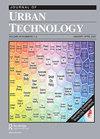Planning Support for Smart Cities in the Post-COVID Era
IF 4.6
3区 经济学
Q1 URBAN STUDIES
引用次数: 7
Abstract
The need for smart cities has been dramatically altered due to the COVID-19 crisis. Information and communications technology (ICT) were critical amid the crisis outburst (contact tracing, health informatics, and remote service provisions), and will remain critical in the post-COVID-19 world where physical contacts are discouraged and replaced by remote working and online meetings (James et al., 2020). Smart city technologies, originally a “fashionable” branding strategy for ambitious cities, have become bread-and-butter infrastructures to support post-pandemic daily lives and work. The urgent need for smart cities expedited endeavors of equipping urban governance with these technologies, which make urban planners increasingly skeptical about how smart cities are planned, who plans them, and for whom they are planned (Jiang et al., 2020; Wang et al., 2021). Planning Support Systems (PSS) were once widely discussed in the literature of planning for smart cities, as they share common technical features including dashboards, largescale models, communication tools, and data systems. However, none of these technologies guarantee citizens’ equitable, inclusive, and sustainable access to smart cities. Two issues are associated with this—process and access. The process focuses on whether PSS can reinvent a governance model that plans along and even builds PSS from scratch together with outside partners and citizens (Barns, 2018). To realize broader collaboration in the process, access should be available through various channels including workshops, open-source web pages, and even smart phones (Lin and Benneker, 2021). This special issue, “Planning Support for Smart and Sustainable Cities” was first planned in November 2019, a time when the world did not have any idea about COVID-19, and it is published in 2022, when urban society has been completely re-shaped by COVID-19. The articles in this issue were either drafted, submitted, or revised amid the most difficult times of the crisis. Our special issue has seven accepted articles, which provide reflections on the unprecedented challenges, demands, and opportunities for smart cities and PSSs.后covid时代的智慧城市规划支持
由于2019冠状病毒病危机,对智慧城市的需求发生了巨大变化。信息和通信技术(ICT)在危机爆发期间至关重要(接触者追踪、卫生信息学和远程服务提供),在不鼓励身体接触并被远程工作和在线会议取代的后covid -19世界中仍将至关重要(James et al., 2020)。智慧城市技术最初是雄心勃勃的城市的一种“时尚”品牌战略,现已成为支持大流行后日常生活和工作的基本基础设施。对智慧城市的迫切需求加速了用这些技术装备城市治理的努力,这使得城市规划者越来越怀疑智慧城市是如何规划的,谁来规划它们,以及为谁规划(Jiang等人,2020;Wang等人,2021)。规划支持系统(PSS)曾在智慧城市规划文献中被广泛讨论,因为它们具有共同的技术特征,包括仪表板、大规模模型、通信工具和数据系统。然而,这些技术都不能保证公民公平、包容和可持续地进入智慧城市。与此相关的两个问题是流程和访问。这个过程的重点是PSS是否可以重塑一个治理模型,与外部合作伙伴和公民一起从头开始规划甚至构建PSS (Barns, 2018)。为了在这个过程中实现更广泛的协作,应该通过各种渠道访问,包括研讨会、开源网页,甚至智能手机(Lin和Benneker, 2021)。本期特刊《规划支持智慧和可持续城市》于2019年11月首次策划,当时世界对COVID-19还没有任何了解,而在2022年出版,此时城市社会已被COVID-19彻底重塑。本期文章是在危机最艰难的时期起草、提交或修改的。我们的特刊收录了7篇文章,对智慧城市和pss面临的前所未有的挑战、需求和机遇进行了反思。
本文章由计算机程序翻译,如有差异,请以英文原文为准。
求助全文
约1分钟内获得全文
求助全文
来源期刊

Journal of Urban Technology
URBAN STUDIES-
CiteScore
8.50
自引率
4.20%
发文量
42
期刊介绍:
The Journal of Urban Technology publishes articles that review and analyze developments in urban technologies as well as articles that study the history and the political, economic, environmental, social, esthetic, and ethical effects of those technologies. The goal of the journal is, through education and discussion, to maximize the positive and minimize the adverse effects of technology on cities. The journal"s mission is to open a conversation between specialists and non-specialists (or among practitioners of different specialities) and is designed for both scholars and a general audience whose businesses, occupations, professions, or studies require that they become aware of the effects of new technologies on urban environments.
 求助内容:
求助内容: 应助结果提醒方式:
应助结果提醒方式:


